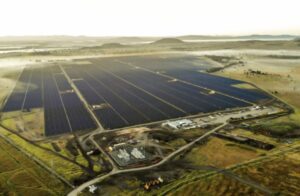Not a day goes by when I don’t learn something new about what solar energy can do and frankly, how much BS exists about “the problems” that it theoretically causes.
I’m no conspiracy theorist but I can’t say I blame them for being suspicious. But what I love most is when facts and data bust the myths being spouted and today, we got an extremely cool new set of truths. Arguably, they could have quite profound global ramifications and this project was conducted right here in Australia.
One of the most common myths we hear is that high solar penetration rates are devastating for the network. High penetration solar can cause changes in voltage and frequency and well, apparently, will just about wreck the whole world if you believe what some people say. Now whilst it’s true that in isolated instances and situations solar adds a new dimension of variability to the energy network here’s the simple fact – the grid is already a highly dynamic and variable beast.
Solar doesn’t wreck things, it just changes things.
A new study released today by the Australian Renewable Energy Agency looked at this very issue. Conducted by the highly esteemed CAT Project’s, the study used the Alice Springs grid network as a test case and in short asked two fundamental questions. The first was “What solar network penetration rates can be accepted without adversely and materially affecting network performance?” and the second was “What affect does geographic dispersion of solar have on the first question?”.
Now you may say “Why choose Alice Springs, one of the remotest towns on earth in the middle of a desert with a small population ?” Turns out that the weather, demand patterns and other factors make Alice Springs highly representative of a huge variety of Australian locations. It’s summers are hot, it’s winter nights very cold and incredulously it even rains there too. It’s grid network is isolated, but as a simulation model of how a much larger National Electricity Market might behave it’s an ideal test location too.
The lessons learned
The first, important, mythbusting fact is this – network demand (ie load) is actually already highly variable. Network demand is not the stable, consistent, smooth profile some suggest but rather is made up of countless, constantly varying individual changes. This is pretty logical when you think about it because although their are load patterns, humans are a diverse lot who do things at different times for sometimes bizarre reasons and constantly changing random factors affect the resulting load pattern. Last night for example, our lights, washing machine and hot water all went on for an hour or so at around 2am (highly unusual) while we sorted out poor old number three son’s upset tummy. The network saw a tiny little unpredicted change in load. Shit happens, as they say.
So, the study measured, analyzed and found in highly granular detail that load varies. So how does solar affect this?
One of the main reasons that Alice Springs was chosen for this project was because it was relatively easy to install a number of monitoring stations at a variety of distances from the CBD without intruding on too many people. Pretty much just a case of throwing your monitoring station over your shoulder and heading out of town then stopping at regular intervals to plonk them on the ground.
What this enabled the team to do was to measure and analyse solar insolation across a diverse geographical range. If clouds passed at one station (reducing solar generation), how long would it take to reach the next one under a wide range of conditions?
The findings come as no surprise to people who understand solar and who have been arguing its merits for eon’s. In some other countries where solar capacity is far larger, the measurement and aggregation of distributed wind and solar generation, load and weather data have been available for years. What these data points have shown is that natural geographic diversity has a smoothing effect; the sun may or may not shine in specific allocations, but when viewed as a whole there is a natural, organic tendency to balance each other out.
And that’s pretty much exactly what they found in Alice Springs.
In the case of Alice Springs, the acceptable spatial geographic diversity was around 5km. What the study found was that average cloud speed and size meant that at this distance, sufficient variation existed such that when one site was underperforming, another would typically be generating just fine. Chatting with the team at CAT Projects, they highlighted a couple of things from these findings. The first was that nature of networks varies and hence, the impact will also. Logically however, the larger and more diverse the network is, the less noticeable the effects of penetration will be, notwithstanding that some areas will be more stressed than others. The second was that of course, weather patterns and cloud types vary around Australia. What this means in reality is that instead of a cloud event taking 6 minutes to pass (for example), on the coast it might take 10 minutes, so the geographic range might change to 10km instead of 6km for example.
The results did show that (logically) if you plonk a huge 10MW wad of solar in one spot in Alice Springs the impact is worse; and it adds more variation to network conditions. This is not ideal although it can be mitigated through power control equipment and network design.
However, if you instead distribute that 10MW wad of solar over a wider geographic area in 1MW wads, the impacts are substantially mitigated – to the point where it is barely discernable over the natural organic variation in load that the network already see’s. In fact the results of the study found that it was “no worse than what the power system already accommodates”.
Scalability
Importantly, the results of this study do lend them self to scalability. The generation capacity, load and PV system size can in a relatively straightforward manner be scaled up to match the demand of far larger network areas; like the entire National Electricity Market for example. As both load and generation size and diversity increases, the impact’s become less intense – as long as the spatial rules are followed.
This highlights an issue that I’ve been arguing for many years (along with many others of course). That is, as soon as the networks get clever and start incentivising and planning solar uptake to match their situation, the sooner we’ll be able to provide even more benefits. A NEM wide solar rollout map with open access to network hotspots is the solution here but the solar industry can’t solve that one – its in the hands of the networks who right now, have little or no incentive to provide the data.
Getting this right is also a key part of the energy revolution in which generation diversity is planned, encouraged and systematically rolled out. It’s a matter of choreographing the technologies, variables and constraints and the intelligence is out there, as we highlighted in the case of Hawaii recently. If you want a visualisation of what this choreography looks like check this awesome video from one of the great TED talks.
Distributed energy
This analysis doesn’t stop clean, centralised generation from making a whole lot of sense; it simply has to be planned well, timed perfectly and put in the right locations. The economies of scale are better and large projects can and should be deployed in the right conditions. However, as we have seen in the case of China for example, installing large volumes of solar in distributed sites is increasingly popular and in many cases far quicker. Recent data from China’s planners reveals that the 15GW solar target in their twelfth 5 year plan is now set at 8GW of central generation and 7GW of distributed generation.
What this ARENA study proved in an entirely statistically valid, Government supported study is this:
- Distributed energy makes a whole lot of sense
- Sufficient geographic spatial diversity overcomes many of the (previously assumed) problems
- Network demand has a lot of natural variability
- Well planned networks can cope with far higher solar penetration than is often assumed
The data from this study is publicly available for all network planners and I just bet the clever folks at CAT Projects would love to help develop a NEM wide roll out map. Hat’s off to ARENA for providing funding support, CAT Projects and everyone else who participated in this awesome piece of work.
Source: Solar Business. Reproduced with permission.








